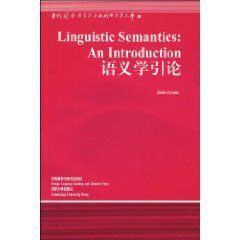內容簡介
《語義學引論》內容簡介:Linguisticsemantics:AnIntroducitionisthesuccessortoSirJohnLyons'stextbookLanguage,Meaningandconteext(1981).Whilepreservingthegeneralstructureoftheearlierbook.theauthorhassubstantiallyexpandeditsscopetointroduceseveraltopicsthatwerenotpreviouslydiscussed,andtotakeaccountofnewdevelopmentsinlinguisticsemanticsoverthepastdecade.Theresultingworkisaninvaluableguidetothesubject.offeringclarificationsofitsspecializedtermsandexplainingitsrelationshiptoformalandphilosophicalsemanticsandtocontemporarypragmatics.withitsclearandaccessiblestyleitwillappealtoawidestudentreadership.
作者簡介
作者:(英國)萊昴斯(JohnLyons)萊昴斯(JohnLyons)isMasteroftrinityHallintheUniversityofcambridge.HeisafellowoftheBritishAcademyandanHonoraryMemberoftheLinguisticsocietyofAmerica.Hismanypublicationsincludestructuralsemantics(1964).IntroductiontoTheoreticalLinguistics(1968).Chomsky(1970),Semantics(2vols.,1977).NaturalLanguageandUniversalGrammar(wov.1ofhiscollectedessays,1991),andLinguisticsemantics:AnIntroduction(1995).
目錄
Preface by Halliday
Preface
List of symbols and typographical conventions
Part 1 Setting the scene
1 Metalinguistic pteliminaries
1.0 Introduction
1.1 The meaning of 'meaning'
1.2 Themetalanguageof semantics
1.3 Linguistic and non-linguistic semantics
1.4 Language,speech andutterancelangue and 'parole';'competence'and 'performance'
1.5 Words :forms and meanings
1.6 Sentences and utterances;text,conversation and siscourse
1.7 Theories of meaning and kinds of meaning
Part 2 Lexical Meaning
2 Words as meanignfufl nuits
2.0 Introduction
2.1 Forms and expressions
2.2 Homonymy and polysemy;lexical and grammaticalambiguity
2.3 Synonymy
2.4 Full and empty word-forms
2.5 Lexical mening and grammatical meaning
3 Defining the meaning of words
4 The structural approach
Part 3 Sentence -meanign
5 Meaningful andmeaninglesssentences
5.0 Introduction
5.1 Grammaticality, acceptability and meaningfulness
5.2 The meaningfulness of sentences
5.3 Corrigibility and translatability
5.4 Verifiability and verificationism
5.5 Propositions and propositional content
5.6 Non-factualsignificance and emotivism
5.7truth-conditions
5.8 Tautologies and contradictions
6 Sentence-meaning andpropositional content
6.0 Introduction
6.1 Thematic meaning
6.2 Simple and composite sentences
6.3 Truth-functionality (1): conjunction anddisjunction
6.4 Truth-functionality (2): implication
6.5 Truth-functionality (3): negation
6.6 Sentence-type, clause-type and mood
6.7 The meaning of interrogative and declarative sentences
6.8 Other kinds of non-declaratives: imperatives,exclamatives, volitives, etc.
7 The formalization of sentence-meaning
7.0 Introduction
7.1 Formal semantics and linguistic semantics
7.2 Compositionality, grammatical and semantic isomorphism, and saving the appearances
7.3 Deep structure and semantic representations
7.4 Projection-rules and selection-restrictions
7.5 Montague grammar
7.6 Possible worlds
Part 4 Utterance -meaning
8 Speech acts and illocutionaryforce
8.0 Introduction
8.1 Utterances
8.2 Locutionary acts
8.3 Illocutionary force
8.4 Statements, questions and directives
9 Text and discourse; context and co-text
9.0 Introduction
9.1 Text-sentences
9.2 What is a text? And what is text?
9.3 Utterance-meaning and context
9.4 Implication and conventional implicatures
9.5 Conversational implicatures
9.6 What is context?
10 The subjectivity of utterance
10.0 Introduction
10.1 Reference
10.2 Indexicality and deixis
10.3 The grammatical category of tense
10.4 The grammatical category of aspect
10.5 Modality, modal expressions and mood
10.6 Subjectivity and locutionary agency
Suggestions for further reading
Bibliography
Index
文庫索引

